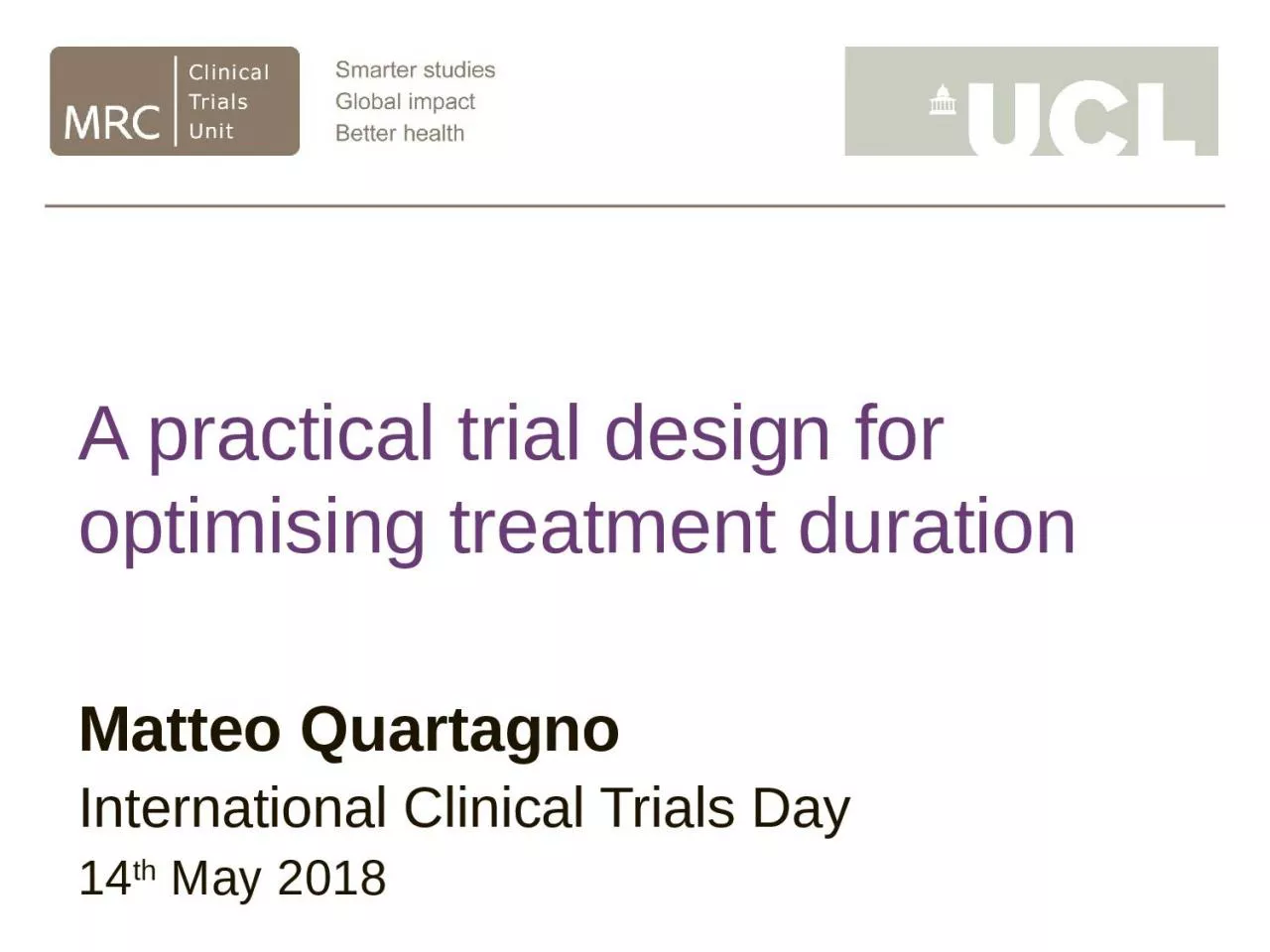

Matteo Quartagno International Clinical Trials Day 14 th May 2018 Acknowledgements This is joint work with Sarah Walker James Carpenter Patrick Phillips and Max Parmar MRC Clinical Trials Unit at UCL ID: 928851
Download Presentation The PPT/PDF document "A practical trial design for optimising ..." is the property of its rightful owner. Permission is granted to download and print the materials on this web site for personal, non-commercial use only, and to display it on your personal computer provided you do not modify the materials and that you retain all copyright notices contained in the materials. By downloading content from our website, you accept the terms of this agreement.
Slide1
A practical trial design for optimising treatment duration
Matteo Quartagno
International Clinical Trials Day
14
th
May 2018
Slide2Acknowledgements
This is joint work with Sarah Walker, James Carpenter, Patrick Phillips and Max Parmar
MRC Clinical Trials Unit at UCL
Slide3Treatment duration: what evidence?
There is little (if any!) evidence in favour of currently recommended treatment durations for many drugs;
Minimizing treatment duration important in different therapeutic areas:
Antibiotics (
AMR
);
TB (
promote adherence
);
Hep C (
costs
).
How to design a trial to optimise treatment duration?
Non-inferiority? Superiority?
2-arm? Multi-arm?
Slide4Standard design: two-arm non-inferiority
7-day non-inferior to 14-day
Slide5Standard design: two-arm non-inferiority
Inconclusive trial
Slide6Issues:
Arbitrariness of
non-inferiority margin
;
Choice of
research arms
to test against control;
Very large
sample size
required (since we expect increasing cure rate with increasing duration).
Standard design: two-arm non-inferiority
Slide7Multi-arm non-inferiority
Only 10-day proven non-inferior to 14-day;
Slide8Issues:
Increase chances to pick
right
research arms;
Same issue with arbitrary non-inferiority margin;
Increase sample size even further.
Multi-arm non-inferiority
Slide9Our idea: modelling duration-response curve
Instead of testing fixed number of research arms against control, we design trial to estimate the whole duration-response curve;
Share information across durations, decreasing sample size;
Only choice is minimum duration;
Extension of work from Horsburgh et al.
Slide10Modelling duration-response curve
Example: currently recommended duration is 14 days.
Slide11Modelling duration-response curve
Example:
cannot randomise patients to no treatment. Only choice: minimum duration.
Slide12Questions:
How do we model duration-response curve?
No prior knowledge about the shape of the curve;
Flexible regression models (FP, splines,
etc
).
How do we design a trial to better estimate this curve?
How many research arms?
How do we space research arm?
What about sample size?
Modelling duration-response curve
Slide13Setting up simulation study
We do not know shape of duration-response curve:
Simulate from a set of plausible scenarios;
Evaluate method across different scenarios;
Evaluate goodness of estimate through area between true and estimated curve;
Divided by duration range to move to probability scale;
sABC
henceforth (scaled Area Between Curves)
Slide14Simulation study: some scenarios
Slide15Simulation study: base-case design
Base-case design parameters:
Sample size:
500
patients
Number of Arms:
7
Position of Arms:
Equidistant
Flexible model:
fractional polynomials (FP2)
1000 simulations for each of 8 scenarios;
In each scenario, 95
th
percentile of
sABC
<5.3%, i.e. less than 5% bias in 95% simulations.
Slide16Simulation study: base-case design
Slide17Simulation study: sensitivity to sample size
95
th
percentiles of
sABC
from 8 simulation scenarios, varying total sample size:
Slide18Simulation study: sensitivity to n of arms
95
th
percentiles of
sABC
from 8 simulation scenarios, varying number of arms:
Slide19Simulation study: flexible regression model
Worst simulation (largest
sABC
) using either
FP2
or
splines (linear, 5 knots)
:
Slide20Simulation study: summary
Sample size: ~
500
enough to estimate duration-response curve within 5% bias in 95% simulations;
Number of arms: We gain nearly nothing for N>
7 arms
;
Position of arms:
Equidistant
or more condensed in part of curve we expect to be less linear: similar results;
Flexible model:
FP
more stable, standard implementation, no additional choices.
Slide21Summary
Designing trials to
optimise treatment durations
important in different areas;
Standard non-inferiority has several issues, moving to superiority is problematic as well;
We proposed modelling whole
duration-response curve
with flexible methods;
Using FP, and randomising ~500 patients to 7 equidistant arms lead to good results under a variety of duration-response curves.
Slide22What’s next?
The outcome of the trial is an estimate of the whole duration-response curve. What to do with this curve estimate?
Simply calculate duration corresponding to specific cure rate (e.g. 5% less than with current control).
Assume there is “acceptability curve”, defining minimum cure rate we would tolerate at each duration, and find point where estimated curve is farthest away.
Decision based on trade-offs. Cost-effectiveness methods?
Slide23What’s next?
Original motivation: Phase-IV trials, treatment already known to be effective.
Possible to use this design for Phase-II trials as well.
It could be used to select most promising duration(s) to use later at Phase-III.
Slide24What’s next?
Adaptive design?
Possibly change minimum duration tested
Use of covariate data (age, sex…)
Move towards personalised medicine;
Application in TB:
How shall we include control arm?
Force monotonicity with FP;
Any comments/suggestions welcome.
Slide25Bibliography
Horsburgh CR,
Shea
KM, Phillips PPJ et al.,
Randomized clinical trials to identify optimal antibiotic treatment duration
, Trials, 2013;14:88.
Quartagno M, Walker AS, Carpenter JR, Phillips PPJ, Parmar MKB,
Rethinking non-inferiority: a practical trial design for optimising treatment duration
, Clinical Trials,
In press.